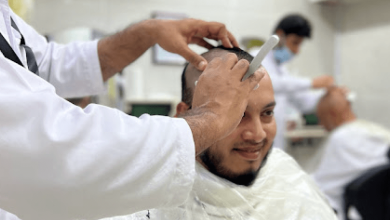The Absence of Beard Growth: Causes, Treatments, and Considerations
Beard growth has long been associated with masculinity, cultural identity, and individual style. While many men naturally develop facial hair as they reach puberty and adulthood, some may experience minimal or no beard growth. This phenomenon is not uncommon and can result from a variety of factors ranging from genetics to hormonal imbalances. Understanding the underlying causes, available treatments, and considerations is crucial for those seeking to address this concern.
Understanding Beard Growth: The Basics
Facial hair growth is predominantly regulated by hormones, particularly testosterone and its derivative, dihydrotestosterone (DHT). Testosterone influences the quantity of hair growth, while DHT determines the quality, such as thickness and texture. The hair follicles on the face have androgen receptors that interact with these hormones, stimulating hair growth.
Beard development usually begins during puberty and may continue into a man’s late twenties or even early thirties. However, the rate and extent of growth vary widely between individuals due to genetic, hormonal, and environmental factors.
Common Causes of Minimal or Absent Beard Growth
-
Genetics
Genetics play a pivotal role in determining whether an individual can grow a beard. If close male relatives, such as fathers or grandfathers, have sparse facial hair, it is likely that the trait has been inherited. Ethnicity also influences beard density; for example, men of East Asian descent often have finer and less dense facial hair compared to men of Mediterranean or Middle Eastern descent. -
Hormonal Imbalances
Low levels of testosterone or poor sensitivity of androgen receptors can impede beard growth. Conditions such as hypogonadism, which results in reduced testosterone production, can significantly affect the development of secondary sexual characteristics, including facial hair. -
Alopecia Areata
Alopecia areata is an autoimmune condition that causes hair loss in localized patches. When it affects facial hair, it is referred to as alopecia barbae. This condition can prevent the full growth of a beard and create patchy areas. -
Nutritional Deficiencies
Inadequate nutrition can affect overall hair growth, including facial hair. Deficiencies in key nutrients such as biotin, zinc, vitamin D, and iron may lead to weaker or absent hair growth. -
Skin Conditions
Skin health is closely tied to hair growth. Conditions such as seborrheic dermatitis, fungal infections, or psoriasis can create an environment that is less conducive to beard growth. -
Age
Younger men may not yet have reached their peak capacity for beard growth. It is common for beard density to increase as men age into their late twenties or thirties. -
Stress and Lifestyle Factors
Chronic stress and poor lifestyle choices, including smoking, lack of sleep, and sedentary habits, can negatively impact testosterone levels and overall hair growth.
Diagnostic Approaches
For individuals concerned about minimal or absent beard growth, a thorough evaluation is essential. A healthcare provider or dermatologist will typically assess:
- Medical and Family History: Understanding genetic predispositions and personal health history.
- Hormonal Testing: Measuring testosterone and DHT levels to identify hormonal imbalances.
- Skin Examination: Identifying any underlying dermatological conditions.
- Nutritional Assessment: Evaluating dietary habits and potential deficiencies.
Treatments and Interventions
-
Topical Treatments
- Minoxidil: Widely used for scalp hair growth, minoxidil can also be applied to the face to stimulate beard growth. It enhances blood flow to hair follicles and extends the hair growth phase.
- Beard Serums: Products containing biotin, peptides, and plant-based extracts may support healthier beard growth.
-
Hormone Replacement Therapy (HRT)
For individuals with low testosterone levels, hormone replacement therapy can address the hormonal imbalance. This treatment should be guided by a healthcare professional due to potential side effects. -
Dietary and Lifestyle Changes
- Nutrition: Incorporating a balanced diet rich in vitamins, minerals, and proteins is vital. Foods such as eggs, nuts, leafy greens, and fish can promote hair growth.
- Exercise: Regular physical activity, especially strength training, can naturally boost testosterone levels.
- Stress Management: Practices like meditation, yoga, and mindfulness can mitigate the effects of chronic stress.
-
Microneedling
Microneedling involves the use of a device with fine needles to create micro-injuries on the skin’s surface. This process stimulates collagen production and improves the absorption of topical treatments like minoxidil. -
Hair Transplants
In cases where beard growth is minimal and other treatments are ineffective, facial hair transplants may be an option. This surgical procedure involves transplanting hair follicles from other parts of the body to the face.
Psychological and Social Considerations
The inability to grow a beard can lead to self-esteem issues or feelings of inadequacy, particularly in cultures where facial hair is a significant marker of maturity or identity. It is important for individuals to recognize that beard growth does not define masculinity or worth. Counseling or support groups can provide emotional support for those struggling with self-image.
Table: Summary of Key Nutrients for Beard Growth
| Nutrient | Role in Beard Growth | Dietary Sources |
|---|---|---|
| Biotin | Promotes keratin production | Eggs, nuts, seeds, whole grains |
| Vitamin D | Regulates hair follicle cycles | Sunlight, fatty fish, fortified foods |
| Zinc | Supports cell reproduction | Meat, shellfish, legumes |
| Iron | Enhances oxygen delivery to follicles | Red meat, spinach, lentils |
| Omega-3 Fatty Acids | Reduces inflammation | Salmon, walnuts, flaxseeds |
Conclusion
While the absence of beard growth may be influenced by various factors, understanding the root cause is the first step toward finding a solution. Whether through medical intervention, lifestyle changes, or acceptance of one’s natural state, addressing concerns about beard growth can be both empowering and transformative. Consulting with healthcare professionals ensures that any underlying health issues are properly managed, and it allows individuals to explore appropriate options to achieve their desired outcomes.




